《有机化学》课程教学课件(Organic Chemistry, Alex Jonathan Roche lecture notes Rutgers The State University NJ, wade 8th)Chapter 13 Nuclear Magnetic Resonance(NMR)Spectroscopy
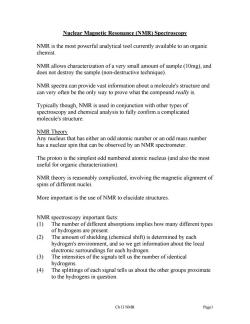
Nuclear Magnetic Resonance (NMR)Spectroscopy NMR is the most powerful analytical tool currently available to an organic chemist. NMR allows characterization of a very small amount of sample (10mg),and does not destroy the sample (non-destructive technique). NMR spectra can provide vast information about a molecule's structure and can very often be the only way to prove what the compound really is. Typically though,NMR is used in conjunction with other types of spectroscopy and chemical analysis to fully confirm a complicated molecule's structure. NMR Theory Any nucleus that has either an odd atomic number or an odd mass number has a nuclear spin that can be observed by an NMR spectrometer. The proton is the simplest odd numbered atomic nucleus(and also the most useful for organic characterization) NMR theory is reasonably complicated,involving the magnetic alignment of spins of different nuclei. More important is the use of NMR to elucidate structures. NMR spectroscopy important facts: (1) The number of different absorptions implies how many different types of hydrogens are present. (2) The amount of shielding (chemical shift)is determined by each hydrogen's environment,and so we get information about the local electronic surroundings for each hydrogen. (3) The intensities of the signals tell us the number of identical hydrogens. (4) The splittings of each signal tells us about the other groups proximate to the hydrogens in question Ch13NMR Pagel
Nuclear Magnetic Resonance (NMR) Spectroscopy NMR is the most powerful analytical tool currently available to an organic chemist. NMR allows characterization of a very small amount of sample (10mg), and does not destroy the sample (non-destructive technique). NMR spectra can provide vast information about a molecule's structure and can very often be the only way to prove what the compound really is. Typically though, NMR is used in conjunction with other types of spectroscopy and chemical analysis to fully confirm a complicated molecule's structure. NMR Theory Any nucleus that has either an odd atomic number or an odd mass number has a nuclear spin that can be observed by an NMR spectrometer. The proton is the simplest odd numbered atomic nucleus (and also the most useful for organic characterization). NMR theory is reasonably complicated, involving the magnetic alignment of spins of different nuclei. More important is the use of NMR to elucidate structures. NMR spectroscopy important facts: (1) The number of different absorptions implies how many different types of hydrogens are present. (2) The amount of shielding (chemical shift) is determined by each hydrogen's environment, and so we get information about the local electronic surroundings for each hydrogen. (3) The intensities of the signals tell us the number of identical hydrogens. (4) The splittings of each signal tells us about the other groups proximate to the hydrogens in question. Ch13 NMR Page1
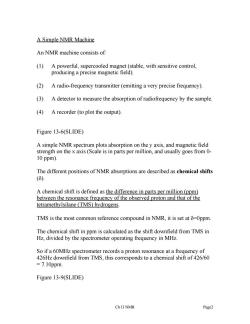
A Simple NMR Machine An NMR machine consists of: (1)A powerful,supercooled magnet(stable,with sensitive control, producing a precise magnetic field) (2)A radio-frequency transmitter(emitting a very precise frequency) (3) A detector to measure the absorption of radiofrequency by the sample. (4) A recorder(to plot the output). Figure 13-6(SLIDE) A simple NMR spectrum plots absorption on the y axis,and magnetic field strength on the x axis(Scale is in parts per million,and usually goes from 0- 10 ppm). The different positions of NMR absorptions are described as chemical shifts (δ) A chemical shift is defined as the difference in parts per million (ppm) between the resonance frequency of the observed proton and that of the tetramethylsilane (TMS)hydrogens. TMS is the most common reference compound in NMR,it is set at 8-0ppm. The chemical shift in ppm is calculated as the shift downfield from TMS in Hz,divided by the spectrometer operating frequency in MHz. So if a 60MHz spectrometer records a proton resonance at a frequency of 426Hz downfield from TMS,this corresponds to a chemical shift of 426/60 =7.10ppm Figure 13-9(SLIDE) Ch13NMR Page2
A Simple NMR Machine An NMR machine consists of: (1) A powerful, supercooled magnet (stable, with sensitive control, producing a precise magnetic field). (2) A radio-frequency transmitter (emitting a very precise frequency). (3) A detector to measure the absorption of radiofrequency by the sample. (4) A recorder (to plot the output). Figure 13-6(SLIDE) A simple NMR spectrum plots absorption on the y axis, and magnetic field strength on the x axis (Scale is in parts per million, and usually goes from 0- 10 ppm). The different positions of NMR absorptions are described as chemical shifts (δ). A chemical shift is defined as the difference in parts per million (ppm) between the resonance frequency of the observed proton and that of the tetramethylsilane (TMS) hydrogens. TMS is the most common reference compound in NMR, it is set at δ=0ppm. The chemical shift in ppm is calculated as the shift downfield from TMS in Hz, divided by the spectrometer operating frequency in MHz. So if a 60MHz spectrometer records a proton resonance at a frequency of 426Hz downfield from TMS, this corresponds to a chemical shift of 426/60 = 7.10ppm. Figure 13-9(SLIDE) Ch13 NMR Page2
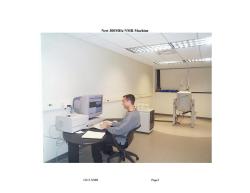
New 300MHz NMR Machine Ch13 NMR Page3
New 300MHz NMR Machine Ch13 NMR Page3
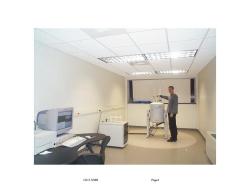
Ch13 NMR Page
Ch13 NMR Page4
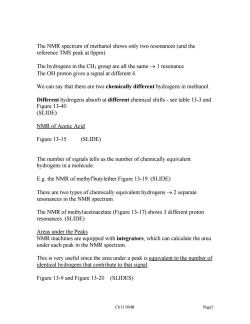
The NMR spectrum of methanol shows only two resonances (and the reference TMS peak at Oppm). The hydrogens in the CH3 group are all the same>1 resonance The OH proton gives a signal at different 8. We can say that there are two chemically different hydrogens in methanol. Different hydrogens absorb at different chemical shifts-see table 13-3 and Figure 13-40 (SLIDE) NMR of Acetic Acid Figure 13-15 (SLIDE) The number of signals tells us the number of chemically equivalent hydrogens in a molecule. E.g.the NMR of methyl'butylether Figure 13-19.(SLIDE) There are two types of chemically equivalent hydrogens>2 separate resonances in the NMR spectrum. The NMR of methylacetoacetate(Figure 13-17)shows 3 different proton resonances.(SLIDE) Areas under the Peaks NMR machines are equipped with integrators,which can calculate the area under each peak in the NMR spectrum. This is very useful since the area under a peak is equivalent to the number of identical hydrogens that contribute to that signal. Figure 13-9 and Figure 13-20 (SLIDES) Ch13 NMR Page5
The NMR spectrum of methanol shows only two resonances (and the reference TMS peak at 0ppm). The hydrogens in the CH3 group are all the same → 1 resonance The OH proton gives a signal at different δ. We can say that there are two chemically different hydrogens in methanol. Different hydrogens absorb at different chemical shifts - see table 13-3 and Figure 13-40 (SLIDE) NMR of Acetic Acid Figure 13-15 (SLIDE) The number of signals tells us the number of chemically equivalent hydrogens in a molecule. E.g. the NMR of methylt butylether Figure 13-19. (SLIDE) There are two types of chemically equivalent hydrogens → 2 separate resonances in the NMR spectrum. The NMR of methylacetoacetate (Figure 13-17) shows 3 different proton resonances. (SLIDE) Areas under the Peaks NMR machines are equipped with integrators, which can calculate the area under each peak in the NMR spectrum. This is very useful since the area under a peak is equivalent to the number of identical hydrogens that contribute to that signal. Figure 13-9 and Figure 13-20 (SLIDES) Ch13 NMR Page5
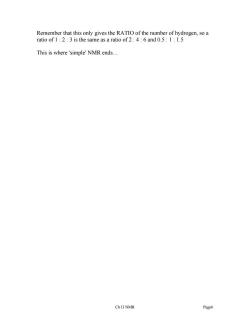
Remember that this only gives the RATIO of the number of hydrogen,so a ratio of 1 2 3 is the same as a ratio of 2 4 6 and 0.5 1 1.5 This is where'simple'NMR ends... Ch13 NMR Page6
Remember that this only gives the RATIO of the number of hydrogen, so a ratio of 1 : 2 : 3 is the same as a ratio of 2 : 4 : 6 and 0.5 : 1 : 1.5 This is where 'simple' NMR ends… Ch13 NMR Page6
按次数下载不扣除下载券;
注册用户24小时内重复下载只扣除一次;
顺序:VIP每日次数-->可用次数-->下载券;
- 《有机化学》课程教学课件(Organic Chemistry, Alex Jonathan Roche lecture notes Rutgers The State University NJ, wade 8th)Chapter 12 Infrared Spectroscopy and Mass Spectrometry.pdf
- 《有机化学》课程教学课件(Organic Chemistry, Alex Jonathan Roche lecture notes Rutgers The State University NJ, wade 8th)Chapter 11 Reactions of Alcohols.pdf
- 《有机化学》课程教学课件(Organic Chemistry, Alex Jonathan Roche lecture notes Rutgers The State University NJ, wade 8th)Chapter 10 Synthesis and Structure of Alcohols.pdf
- 《有机化学》课程教学课件(Organic Chemistry, Alex Jonathan Roche lecture notes Rutgers The State University NJ, wade 8th)Chapter 09 Alkynes.pdf
- 《有机化学》课程教学课件(Organic Chemistry, Alex Jonathan Roche lecture notes Rutgers The State University NJ, wade 8th)Chapter 08 Reactions of Alkenes.pdf
- 《有机化学》课程教学课件(Organic Chemistry, Alex Jonathan Roche lecture notes Rutgers The State University NJ, wade 8th)Chapter 07 Structure and Synthesis of Alkenes.pdf
- 《有机化学》课程教学课件(Organic Chemistry, Alex Jonathan Roche lecture notes Rutgers The State University NJ, wade 8th)Chapter 06 Alkyl Halides.pdf
- 《有机化学》课程教学课件(Organic Chemistry, Alex Jonathan Roche lecture notes Rutgers The State University NJ, wade 8th)Chapter 05 Stereochemistry.pdf
- 《有机化学》课程教学课件(Organic Chemistry, Alex Jonathan Roche lecture notes Rutgers The State University NJ, wade 8th)Chapter 04 Rates & Kinetics.pdf
- 《有机化学》课程教学课件(Organic Chemistry, Alex Jonathan Roche lecture notes Rutgers The State University NJ, wade 8th)Chapter 03 Alkanes.pdf
- 《有机化学》课程教学课件(Organic Chemistry, Alex Jonathan Roche lecture notes Rutgers The State University NJ, wade 8th)Chapter 02 Structure and Properties.pdf
- 《有机化学》课程教学课件(Organic Chemistry, Alex Jonathan Roche lecture notes Rutgers The State University NJ, wade 8th)Chapter 01 Introduction.pdf
- 《有机化学》课程PPT教学课件(Organic Chemistry with Biological Applications, 3th Edition, John McMurry, 2016)Chapter 27 Synthetic Polymers.ppt
- 《有机化学》课程PPT教学课件(Organic Chemistry with Biological Applications, 3th Edition, John McMurry, 2016)Chapter 26 Orbitals and Organic Chemistry - Pericyclic Reactions.ppt
- 《有机化学》课程PPT教学课件(Organic Chemistry with Biological Applications, 3th Edition, John McMurry, 2016)Chapter 25 Secondary Metabolites - An Introduction to Natural Products Chemistry.ppt
- 《有机化学》课程PPT教学课件(Organic Chemistry with Biological Applications, 3th Edition, John McMurry, 2016)Chapter 24 Biomolecules - Nucleic Acids and Their Metabolism.ppt
- 《有机化学》课程PPT教学课件(Organic Chemistry with Biological Applications, 3th Edition, John McMurry, 2016)Chapter 23 Biomolecules - Lipids and Their Metabolism.ppt
- 《有机化学》课程PPT教学课件(Organic Chemistry with Biological Applications, 3th Edition, John McMurry, 2016)Chapter 22 Carbohydrate Metabolism.ppt
- 《有机化学》课程PPT教学课件(Organic Chemistry with Biological Applications, 3th Edition, John McMurry, 2016)Chapter 21 Biomolecules - Carbohydrates.ppt
- 《有机化学》课程PPT教学课件(Organic Chemistry with Biological Applications, 3th Edition, John McMurry, 2016)Chapter 20 Amino Acid Metabolism.ppt
- 《有机化学》课程教学课件(Organic Chemistry, Alex Jonathan Roche lecture notes Rutgers The State University NJ, wade 8th)Chapter 14 Ethers and Epoxides.pdf
- 《有机化学》课程教学课件(Organic Chemistry, Alex Jonathan Roche lecture notes Rutgers The State University NJ, wade 8th)Chapter 15 Conjugated Systems.pdf
- 《有机化学》课程教学课件(Organic Chemistry, Alex Jonathan Roche lecture notes Rutgers The State University NJ, wade 8th)Chapter 16 Aromatic Compounds.pdf
- 《有机化学》课程教学课件(Organic Chemistry, Alex Jonathan Roche lecture notes Rutgers The State University NJ, wade 8th)Chapter 17 Reactions of Aromatic Compounds.pdf
- 《有机化学》课程教学课件(Organic Chemistry, Alex Jonathan Roche lecture notes Rutgers The State University NJ, wade 8th)Chapter 18 Ketones and Aldehydes.pdf
- 《有机化学》课程教学课件(Organic Chemistry, Alex Jonathan Roche lecture notes Rutgers The State University NJ, wade 8th)Chapter 19 Amines.pdf
- 《有机化学》课程教学课件(Organic Chemistry, Alex Jonathan Roche lecture notes Rutgers The State University NJ, wade 8th)Chapter 20 Carboxylic Acids.pdf
- 《有机化学》课程教学课件(Organic Chemistry, Alex Jonathan Roche lecture notes Rutgers The State University NJ, wade 8th)Chapter 21 Carboxylic acid Derivatives.pdf
- 《有机化学》课程PPT教学课件(Organic Chemistry, William A. Price, Ph.D. PPT, La Salle University, L.G.WADE, JR., 8th Edition)CHM 201 Introduction and Review - Structure and Bonding.pptx
- 《有机化学》课程PPT教学课件(Organic Chemistry, William A. Price, Ph.D. PPT, La Salle University, L.G.WADE, JR., 8th Edition)Structure and Bonding of Organic Molecules.pptx
- 《有机化学》课程PPT教学课件(Organic Chemistry, William A. Price, Ph.D. PPT, La Salle University, L.G.WADE, JR., 8th Edition)Alcohols-structure and synthesis 2.ppt
- 《有机化学》课程PPT教学课件(Organic Chemistry, William A. Price, Ph.D. PPT, La Salle University, L.G.WADE, JR., 8th Edition)Alkenes Overview.ppt
- 《有机化学》课程PPT教学课件(Organic Chemistry, William A. Price, Ph.D. PPT, La Salle University, L.G.WADE, JR., 8th Edition)Alkenes Reactions.ppt
- 《有机化学》课程PPT教学课件(Organic Chemistry, William A. Price, Ph.D. PPT, La Salle University, L.G.WADE, JR., 8th Edition)Alkyl Halides from Alcohols.ppt
- 《有机化学》课程PPT教学课件(Organic Chemistry, William A. Price, Ph.D. PPT, La Salle University, L.G.WADE, JR., 8th Edition)Alkynes McMurry.ppt
- 《有机化学》课程PPT教学课件(Organic Chemistry, William A. Price, Ph.D. PPT, La Salle University, L.G.WADE, JR., 8th Edition)Benzene and Aromaticity(2011).ppt
- 《有机化学》课程PPT教学课件(Organic Chemistry, William A. Price, Ph.D. PPT, La Salle University, L.G.WADE, JR., 8th Edition)Carboxylic Acid Derivatives.ppt
- 《有机化学》课程PPT教学课件(Organic Chemistry, William A. Price, Ph.D. PPT, La Salle University, L.G.WADE, JR., 8th Edition)Carboxylic Acids Nitriles.ppt
- 《有机化学》课程PPT教学课件(Organic Chemistry, William A. Price, Ph.D. PPT, La Salle University, L.G.WADE, JR., 8th Edition)Stereochemistry.ppt
- 《有机化学》课程PPT教学课件(Organic Chemistry, William A. Price, Ph.D. PPT, La Salle University, L.G.WADE, JR., 8th Edition)Chemistry of Aromatic Compounds.ppt
